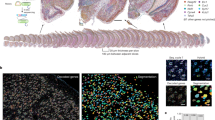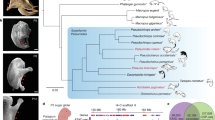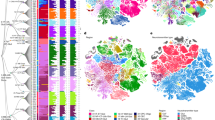Abstract
The pancreas contains both exocrine and endocrine cells, but the molecular mechanisms controlling the differentiation of these cell types are largely unknown. Despite their endodermal origin, pancreatic endocrine cells share several molecular characteristics with neurons1,2,3,4,5, and, like neurons in the central nervous system6,7, differentiating endocrine cells in the pancreas appear in a scattered fashion within a field of progenitor cells8,9. This indicates that they may be generated by lateral specification through Notch signalling6,7. Here, to test this idea, we analysed pancreas development in mice genetically altered at several steps in the Notch signalling pathway. Mice deficient for Delta-like gene 1 (Dll1)10 or the intracellular mediator RBP-Jκ11 showed accelerated differentiation of pancreatic endocrine cells. A similar phenotype was observed in mice over-expressing neurogenin 3(ngn 3)12 or the intracellular form of Notch3 (ref. 13) (a repressor of Notch signalling). These data provide evidence that ngn3 acts as pro-endocrine gene and that Notch signalling is critical for the decision between theendocrine and progenitor/exocrine fates in the developing pancreas.
This is a preview of subscription content, access via your institution
Access options
Subscribe to this journal
Receive 51 print issues and online access
$199.00 per year
only $3.90 per issue
Buy this article
- Purchase on Springer Link
- Instant access to full article PDF
Prices may be subject to local taxes which are calculated during checkout




Similar content being viewed by others
References
Pictet, R. L., Rall, L. B., Phelps, P. & Rutter, W. J. The neural crest and the origin of the insulin-producing and other gastrointestinal hormone producing cells. Science 191, 191–192 (1976).
Fontaine, J. & Le Douarin, N. M. Analysis of endoderm formation in the avian blastoderm by the use of quail-chick chimaeras. The problem of the neurectodermal origin of the cells of the APUD series. J. Embryol. Exp. Morphol. 41, 209–222 (1977).
Le Douarin, N. M. On the origin of pancreatic endocrine cells. Cell 53, 169–171 (1988).
Slack, J. M. W. Developmental biology of the pancreas. Development 121, 1569–1580 (1995).
Edlund, H. Transcribing pancreas. Diabetes 47, 1817–1823 (1998).
Lewis, J. Neurogenic genes and vertebrate neurogenesis. Curr. Op. Neurobiol. 6, 3–10 (1996).
Beatus, P. & Lendahl, U. Notch and neurogenesis. J. Neurosci. Res. 54, 125–136 (1998).
Pictet, R. & Rutter, WJ. in Handbook of Physiology (eds Steiner, D. F. & Frenkel, N.) 25–66 (Williams and Wilkins, Washington, DC, 1972).
Ahlgren, U., Pfaff, S., Jessel, T. M., Edlund, T. & Edlund, H. Independent requirement for ISL1 in the formation of the pancreatic mesenchyme and islet cells. Nature 385, 257–260 (1997).
Hrabe de Angelis, M., McIntyrell, J. & Gossler, A. Maintenance of somite borders in mice requires the Delta homologue Dll1. Nature 386, 717–721 (1997).
Oka, C. et al. Disruption of the mouse RBPJk gene results in early embryonic death. Development 121, 3291–3301 (1995).
Sommer, L., Ma, Q. & Anderson, D. J. Neurogenins, a novel family of atonal-related bHLH transcription factors, are putative mammalian neuronal determination genes that reveal progenitor cell heterogeneity in the developing CNS and PNS. Mol. Cell. Neurosci. 8, 221–241 (1996).
Lardelli, M., Williams, R., Mitsiadis, T. & Lendahl, U. Expression of the Notch 3 intracellular domain in mouse central nervous system progenitor cells is lethal and leads to disturbed neural tube development. Mech. Dev. 59, 177–190 (1996).
Ma, Q., Kintner, C. & Anderson, D. Identification of neurogenin, a vertebrate neuronal determination gene. Cell 87, 43–52 (1996).
Ma, Q., Chen, Z., del Barco Barrantes, I., de la Pompa, J. L. & Anderson, D. J. neurogenin1 is essential for the determination of neuronal precursors for proximal cranialsensory ganglia. Neuron 20, 469–482 (1998).
Fode, C. et al. The bHLH protein NEUROGENIN 2 is a determination factor for epibranchial placode-derived sensory neurons. Neuron 20, 483–494 (1998).
Thor, S., Ericson, J., Brannstrom, T. & Edlund, T. The homeodomain LIM protein Isl-1 is expressed in subsets of neurons and endocrine cells in the adult rat. Neuron 7, 881–889 (1991).
Apelqvist, & & å., & Ahlgren, U. & Edlund, H. Sonic hedgehog directs specialised mesoderm differentiation in the intestine and pancreas. Curr. Biol. 7, 801–804 (1997).
Upchurch, B. H., Aponte,,, G. W. & Liter, A. B. Peptide YY expression is an early event in colonic endocrine cell differentiation: evidence from normal and transgenic mice. Development 120, 245–252 (1994).
Naya, F. J., Stellrecht, C. M. & Tsai, M. J. Tissue-specific regulation of the insulin gene by a novel basic helix–loop–helix transcription factor. Genes Dev. 9, 1009–1019 (1995).
Lee, J. E. et al. Conversion of Xenopus into neurons by NeuroD, a basic helix–loop–helix protein. Science 268, 836–844 (1995).
Naya, F. J. et al. Diabetes, defective pancreatic morphogenesis, and abnormal enteroendocrine differentiation in BETA2/neuroD-deficient mice. Genes Dev. 11, 2323–2334 (1997).
Mitsiadis, T. A., Henrique, D., Thesleff, I. & Lendahl, U. Mouse Serrate-1 expression in the developing tooth is regulated by epithelial-mesenchymal interactions and fibroblast growth factor-4. Development 124, 1473–1483 (1997).
Mitsiadis, T. A., Hirsinger, E., Lendahl, U. & Goridis, C. Delta-Notch signalling in odontogenesis: correlation with cytodifferentiation and evidence for feedback regulation. Dev. Biol. 204, 420–431 (1998).
Ishibashi, M. et al. Targeted disruption of mammalian hairy and Enhancer of split homolog-1 (HES-1) leads to up-regulation of neural helix–loop–helix factors, premature neurogenesis, and severe neural tube defects. Genes Dev. 15, 3136–3148 (1995).
Beatus, P., Lundkvist, J., Öberg, C. & Lendahl, U. The Notch 3 intracellular domain represses Notch-1mediated activation through Hairy/Enhancer of split (HES) promoters. Development 126, 3925–3935 (1999).
Krapp, A. et al. The p48 DNA-binding subunit of transcription factor PTF1 is a new exocrine pancreas-specific basic helix–loop–helix protein. EMBO J. 15, 4317–4329 (1996).
Krapp, A. et al. The bHLH protein PTF1-p48 is essential for the formation of the exocrine and the correct spatial organization of the endocrine pancreas. Genes Dev. 12, 3752–3763 (1998).
Hogan, B., Constantini, F. & Lacey, E. in Manipulating the Mouse Embryo: A Laboratory Manual (Cold Spring Harbour Lab. Press, New York, 1994).
Ohlsson, H., Karlsson, K. & Edlund, T. IPF1, a homeodomain-containing transactivator of the insulin gene. EMBO J. 12, 4251–4259 (1993).
Acknowledgements
We thank K. Falk, U. B. Backman, U. Valtersson and I. Berglund for technical assistance; T. Edlund for critical reading and comments; and members of our laboratories for helpful discussions. This work was supported by grants from the Swedish Medical Research Council and the Juvenile Diabetes Foundation, New York (to H.E.)
Author information
Authors and Affiliations
Corresponding author
Rights and permissions
About this article
Cite this article
Apelqvist, Å., Li, H., Sommer, L. et al. Notch signalling controls pancreatic cell differentiation. Nature 400, 877–881 (1999). https://doi.org/10.1038/23716
Received:
Accepted:
Issue Date:
DOI: https://doi.org/10.1038/23716
This article is cited by
-
Metabolic memory: mechanisms and diseases
Signal Transduction and Targeted Therapy (2024)
-
Islets in the body are never flat: transitioning from two-dimensional (2D) monolayer culture to three-dimensional (3D) spheroid for better efficiency in the generation of functional hPSC-derived pancreatic β cells in vitro
Cell Communication and Signaling (2023)
-
Arginine 65 methylation of Neurogenin 3 by PRMT1 is required for pancreatic endocrine development of hESCs
Experimental & Molecular Medicine (2023)
-
Protocol development to further differentiate and transition stem cell-derived pancreatic progenitors from a monolayer into endocrine cells in suspension culture
Scientific Reports (2023)
-
Jag1-Notch cis-interaction determines cell fate segregation in pancreatic development
Nature Communications (2023)
Comments
By submitting a comment you agree to abide by our Terms and Community Guidelines. If you find something abusive or that does not comply with our terms or guidelines please flag it as inappropriate.



